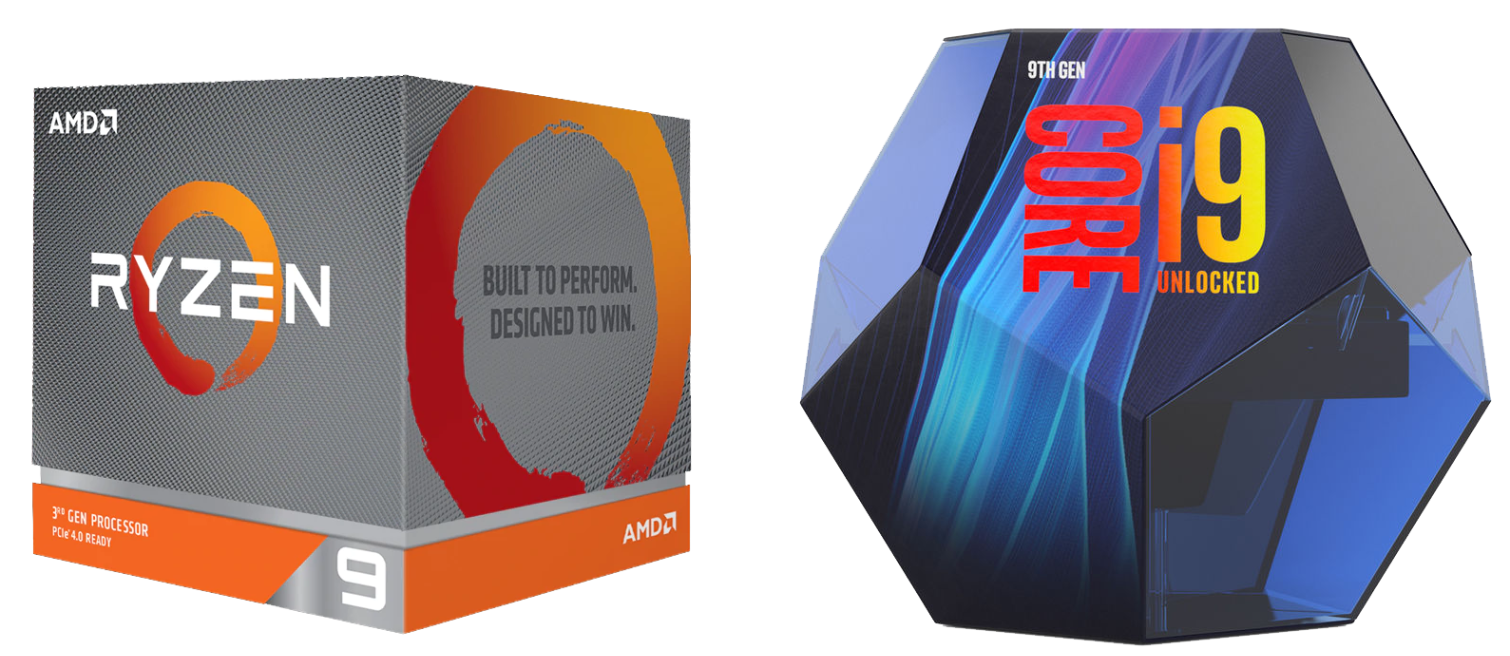AMD Ryzen 9 3900X vs Intel Core i9-9900K: Which CPU Is Better?
With AMD’s recent release of the new Zen 2 architecture and Ryzen 3000 series processors, the CPU landscape has seen a paradigm shift. In the past, Intel took the performance crown with a higher price point, while AMD was typically the value proposition and behind in overall performance. But AMD has caught up and, in many respects, surpassed Intel on performance, while retaining the price advantage per core and thread. Given that, which high-end CPU to choose may seem like an easy choice, but in reality, things are a bit more complicated.
We’ll put AMD’s new 12-core Ryzen 9 3900X (the company’s current flagship, at least until the 16-core Ryzen 9 3950X arrives in September) up against Intel’s top mainstream part, the Core i9-9900K in a number of categories below, to help you decide which one is right for your high-end computing needs. If you're looking for a broader selection of chip comparisons, you can also head to our CPU Benchmark Hierarchy.
We’ll take a look at high-level features, available motherboards, overclocking, power consumption, gaming performance, productivity and value to determine which is the better CPU. But while these battles will certainly shed some light on the situation, in the end the right answer for you will depend on your desires and what, exactly, you’ll be doing with your new processor.
Features
AMD’s Ryzen 9 3900X is a 12-core 24-thread processor with a 3.6 GHz base clock and the ability to turbo (AMD calls it Precision Boost 2) up to 4.6 GHz, while slotting into a 105W TDP. The CPU is technically the second processor in the product stack, behind the previously-mentioned 3950X. Both CPUs blur the lines between mainstream and HEDT systems, as the Intel i9 did previously. The new CPU 7nm architecture (manufactured by TSMC), down from 12nm Zen+ and 14nm Zen on previous Ryzen chips, is part of what provides the notable improvements with AMD’s new CPUs.
In addition to the process node shrink, Zen 2 improves upon memory speed support, raising its base spec to DDR4-3200 from the previous version’s support of DDR4-2933 (Zen+/Ryzen 2000) and DDR4-2667 (Zen/ original Ryzen). Where Zen and Zen+ were a bit more limited in speed, we’ve seen support on X570 motherboards reaching into the DDR4-4000 range. Reaching these speeds is not a guarantee, however, and relies on a good integrated memory controller (IMC), motherboard, and a compatible memory kit. Under sub-ambient cooling we have seen memory paired with Ryzen 3000 CPUs reach DDR4 5000+, in fact. AMD recommends a more realistic speed of DDR4 3600, though.
One of the other changes with Zen 2 and the X570 chipset is the implementation of PCIe 4.0. The new Zen 2 CPUs and X570-based motherboards’ upgrade from PCIe 3.0 (the speed of both AMD’s previous-gen motherboard chipsets, as well as all current Intel boards) doubles the bandwidth from 32 GBps to 64 GBps. This change can help with storage and content creation, but at the moment it has no perceivable impact on gaming performance, as bandwidth isn’t currently saturated with today’s graphics cards.
| Header Cell - Column 0 | Intel Core i9-9900K | AMD Ryzen 9 3900X |
|---|---|---|
| Architecture | Coffee Lake | Zen 2 |
| Socket | 1151 | AM4 |
| Cores / Threads | 8 / 16 | 12 / 24 |
| Base Frequency (GHz) | 3.6 | 3.8 |
| Boost Frequency (Active Cores - GHz) | 1/2 Cores - 5.03/4 Cores - 4.85-8 Cores - 4.7 | 4.6 (1 Core) |
| L3 Cache (MB) | 16 | 64 |
| Process | 14nm++ | 7nm |
| TDP (Watts) | 95 | 105 |
| Memory Speed (official) | DDR4-2666 | DDR4-3200 |
| Memory Controller | Dual-Channel | Dual-Channel |
| Integrated UHD Graphics | GT2 - Up to 1200MHz | No |
| Recommended Customer Pricing | $488 | $499 |
The Intel Core i9-9900K processor jumps into the ring at a 50% core count disadvantage bringing its eight-core, 16-thread capabilities up against the similarly-priced 3900X. Clock speeds on the i9-9900K start off a bit lower with a base speed of 3.6 GHz (vs. 3.8 GHz), but Intel’s turbo functionality brings it to 5.0 GHz for two cores, which are well past AMD’s peak turbo spec. Single-threaded application performance will generally side with Intel when it’s allowed to boost fully, due to the higher clock speeds.
Get Tom's Hardware's best news and in-depth reviews, straight to your inbox.
Base memory support on the Coffee Lake-based CPUs is DDR4-2666, which is much lower than Zen 2 base spec. That said, Intel-based systems (with compatible boards) are able to generally reach memory speeds approaching 4000 MHz (or more with good IMC/board/memory). With similar speeds reachable with the Ryzen 9 3900X and an X570 board, memory support specifically is closer to a tie than it seems.
AMD also offers its capable Ryzen Master software, which allows for fine-grained control of the processor. You also get free access to its Precision Boost Overdrive feature, which uses sophisticated real-time algorithms to dynamically overclock your processor based upon chip quality, your cooling solution, motherboard capabilities, and power supply’s ability to feed the motherboard. That wrings the utmost in performance out of the chip, and all with one click of the button.
Intel also recently unveiled its Performance Maximizer software, which automatically overclocks your processor (9th-Gen K-Series models only), but in comparison, it is far less sophisticated than AMD’s Precision Boost Overdrive. While AMD’s implementation is dynamic and can react to different types of workloads and environmental conditions on the fly, Intel’s software sets a static profile that dictates performance regardless of changes to your system. It also only applies to Intel’s priciest chips, while AMD’s suite comes with every SKU.
AMD also ships all of its processors with a bundled cooler, while Intel doesn’t provide a cooler with it’s pricey K-series chips. In the case of the Ryzen 9 3900X, you get a Wraith Prism RGB cooler (yes, it comes with RGB bling) that can more than sufficiently handle the chips heat output at stock, and even grants some limited overclocking headroom, too.
Winner: AMD
With IPC performance being similar, AMD rules the roost here with a higher core count, better power efficiency at stock, a faster base memory spec, as well as bringing PCIe 4.0. While the latter doesn’t matter much (if anything) performance-wise for gaming, new PCIe 4.0 M.2 drives will offer much-faster sequential speeds. AMD’s 12 cores and 24 threads for a similar price as Intel’s 8/16 offering is certainly compelling for buyers who can utilize that much parallel compute.
Motherboard Options
With Zen 2’s release, AMD brought forth a new chipset in X570, allowing users access to PCIe 4.0, as well as a generally more robust power delivery capable of driving the entire lineup, including the yet-to-be-released flagship 16-core, 32-thread Ryzen 9 3950X.
Pricing on the X570 boards ranges from around $150 to over $1000, which on the high end is a notable increase over X470 flagships. Overall, X570 motherboard pricing has gone up mainly due to the more robust VRMs as well as the PCIe re-drivers and other bits that enable PCIe 4.0 support. It is particularly impressive that AMD, once known as being the value alternative to Intel, is now leading the industry by blazing a path to the ultra-speedy PCIe 4.0 interface.
Features wise, the X570 boards also include native USB 3.1 Gen2 (10 Gbps) support and more capable power delivery designed to better support the new chips, particularly while overclocking.
X570 aside, one of the selling points of the new Ryzen CPUs is backward compatibility with previous-generation chipsets. Support goes all the way back to B350, in fact. This move allows users who don’t care about PCIe 4.0 support to save money by using the same motherboard and dropping in a Zen 2-based CPU, or buying a “new” board with an older chipset for much less money.
In total between the five major AIBs (ASRock, Asus, Biostar, Gigabyte and MSI), users currently have thirty X570 boards to choose from. Each board partner has a full range of boards and feature sets from ITX to E-ATX, and covers a wide gamut of pricing and features.
On the Intel side, while X570 is brand-new, the Z390 chipset has been out for nearly a year. With the Z390 chipset came with native support for Coffee Lake-based CPUs as well as USB 3.1 Gen2 (10 Gbps) support, Wireless-AC 2x2 160 MHz WiFi, and uses the PCIe 3.0 specification.
Most Z390 boards are capable of driving the i9-9900K--at least at stock settings.
Between the same five board partners, there are 58 boards to choose from just on Z390. This does not include Z370 or the lesser chipsets in B360 and H370 (which can’t be used for CPU overclocking).
Winner: Intel
Both CPU companies’ latest motherboards offer similar feature sets, including overclocking and native USB 3.1 Gen 2 support. Though X570 has PCIe 4.0, this doesn’t matter at this time for gaming, though it does allow for faster storage. Pricing, on average, is going to be higher for the X570 chipsets boards. As time goes on, prices will likely go down on that front, and we expect to see more X570 board models hit the market as well. The nod goes to Intel for now due to an overall cheaper price range and higher overclocking potential, along with partial integration of Wireless-AC, something that isn’t part of X570.
Overclocking Potential
Both the AMD and Intel CPUs support overclocking, though how each company handles that in the product stack are different. On one hand, all AMD Ryzen processors are unlocked from the factory, while Intel limits overclocking to the more expensive K-variants and “Z” chipsets. AMD on the other hand allows overclocking a bit further down the product stack to its B450 chipset.
Intel over the last couple of generations has been able to reach a higher peak overclock when using ambient cooling methods (sub-ambient as well). The i9-9900K peaks somewhere around the 4.8-5.0 GHz mark with adequate cooling using all cores and threads. This amounts to a 1.2 - 1.4 GHz overclock from the base frequency. Some samples can reach another 100-200 MHz above 5 GHz, but that’s not as common. Reaching that high may require delidding to keep the temperatures under control, even though the CPU uses solder thermal interface material (sTIM) between the die and IHS.
Since Ryzen hit the scene, the 7nm process itself seems to get in the way of high clock speeds, placing what feels like a hard ceiling on ambient overclocks. Though new, from what we have seen in our review as well as others on the web, the Ryzen 9 3900X tops out around 4.3 GHz (Give or take 100 MHz) when manually overclocking all cores. From base clock to fully overclocked, that is a mere 500 MHz increase. AMD seems to push these CPUs about as far as they can go out of the box with its built-in Precision Boost overclocking.
The Intel CPUs tend to yield a more significant performance increase in most tasks, where overclocking a Ryzen CPU doesn’t offer a whole lot in the way of noticeable performance gains due to the Precision Boost technology already pushing the CPU to its performance limits (assuming you have a capable motherboard and cooler) at stock.
Winner: Intel
The Intel CPUs reach a much higher peak overclock speed as well as gaining more performance in the process. The i9-9900K wins this round, hands down, with easily better overclocking potential.
Gaming Performance
For many, how a CPU performs in games has long been a measure for how a CPU performs, period. In the past, AMD CPUs were always lagging behind at 1080p at times (and in specific games) by a significant margin. With the release of Zen 2 and its increased cache size, which AMD markets as “gaming cache,” AMD tried to close that gap, and was quite successful in doing so.
The 3900X, when allowed to stretch its legs with Precision Boost Overdrive (PBO), significantly outperforms the previous-generation Ryzen 7 2700X, and in many cases is just a few to several frames per second (fps) behind the i9-9900K. This change yields an average of 4.3% performance difference between the two CPUs in our testing.







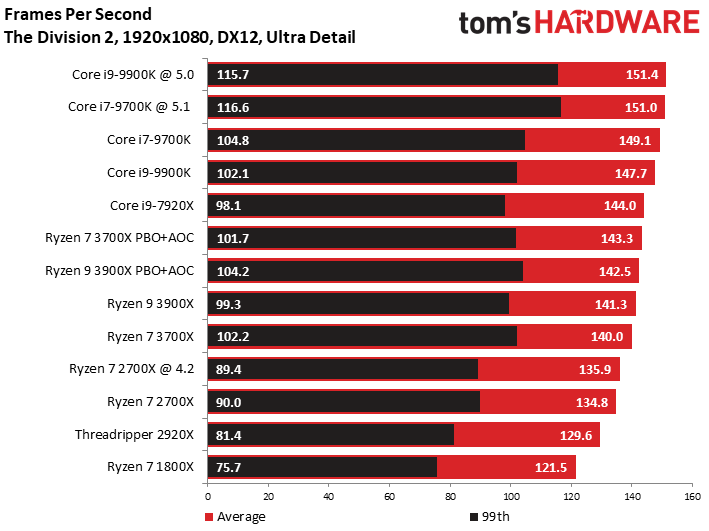

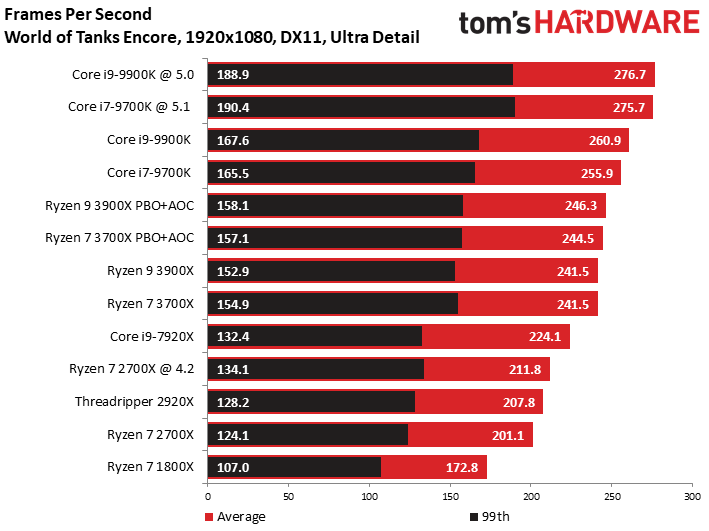




Intel has been the leader in gaming performance for decades. Team blue’s IPC (instructions per cycle) and higher speeds have typically yielded superior performance over the AMD CPUs. And for the most part, that hasn’t changed, though Intel’s lead has shrunk significantly.
When the i9-9900K is manually overclocked to 5 GHz, that lead increases to an average of 14.5% across all our tested titles. As it stands, many games simply cannot utilize the extra cores and threads the 3900X has to offer and rely more on clock speeds and IPC performance. In time that may change, but for now higher clocks still rule the 1080p gaming world. But as we’ve said many times before, once you step above that resolution, gaming performance tends to even out as the graphics card becomes the bottleneck.
Winner: Intel
AMD has most certainly narrowed the gap in 1080p gaming performance with Zen 2 when running the CPU at stock speeds, and the company is even able to perform better than the i9-9900k in a few CPU-heavy titles. But in the end, Intel’s i9 CPU allows high-end GPU’s to stretch their legs the most. While the difference at stock speeds isn’t noticeable for many, those who are running high-refresh monitors and looking to extract every frame possible out of their system will want to use the -9900K, especially when overclocked.
Productivity Performance
On the productivity side of things, AMD and the 3900X really show their strengths. From web to MS Office, the 3900x beats even the 5 GHz i9-9900K in much of our testing. Only in the video conferencing, photo editing, and spreadsheet work does the Intel CPU take the lead.










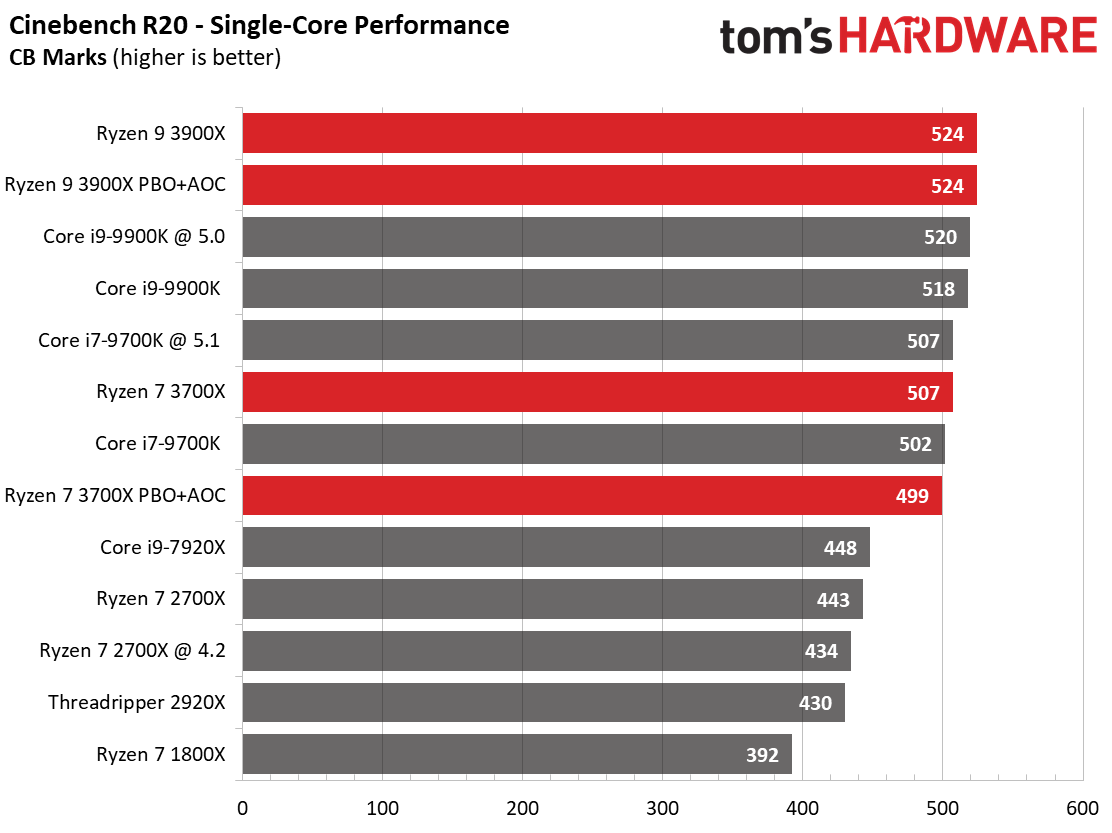







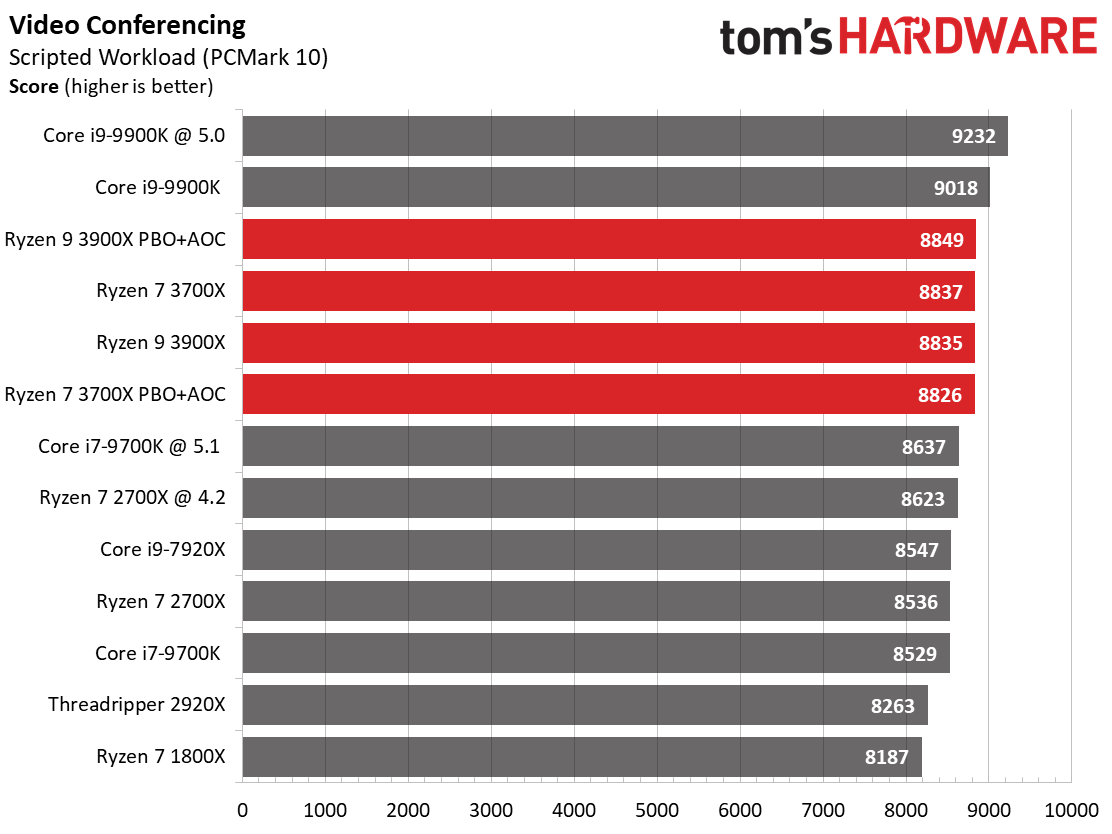







Outside of that and application startup (where clocks and IPC rule) anywhere the 3900X can make use of its extra cores and threads, it performs better. This includes Corona, Blender, Luxmark, and Cinebench (multi-thread).

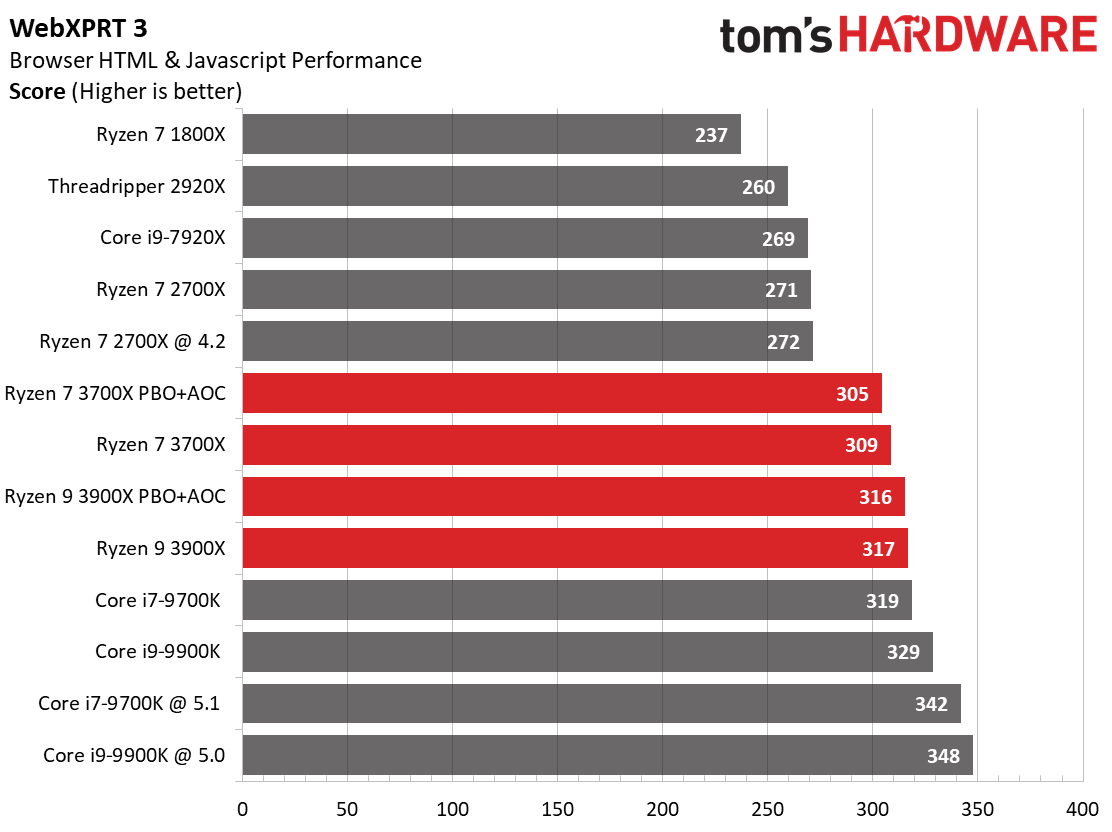






The AMD processor also handles encoding duties quite well. We saw it easily beating out the Intel offerings in 7Zip, Handbrake, VeraCrypt AES, and Geekbench. Intel and the Core i9-9900K do make a solid showing and flex its per-core performance advantage, though, in single-thread Geekbench, Cinebench R15, and Y-Cruncher.
Winner: AMD
Without a doubt, anywhere the Ryzen 9 3900X can use its cores and threads fully, it’s the better productivity based CPU. If the applications used are not heavily threaded, the i9-9900K shows off its prowess. As time goes on we should see an increase in core use by software, so the AMD CPU should have a longer lifespan in particular with multi-threaded applications.
Power Consumption
The 3900X is a 105W part, while the i9-9900K is listed as a 95W part. But Intel and AMD have two different ways they measure TDP, and neither is an actual measurement of power consumption, and were never meant to be. TDP measurements aren’t meant to be an accurate gauge of power consumption.
At stock speed in the AIDA stress test, the AMD processor uses 142W while the Intel CPU hits 113W. Using all those cores and threads seems to use quite a bit more power on the AMD CPU. If we overclock the i9-9900K to 5GHz and enable PBO on the Ryzen 9 3900X, the Intel CPU now uses more power at 175W versus the AMD at 168W.




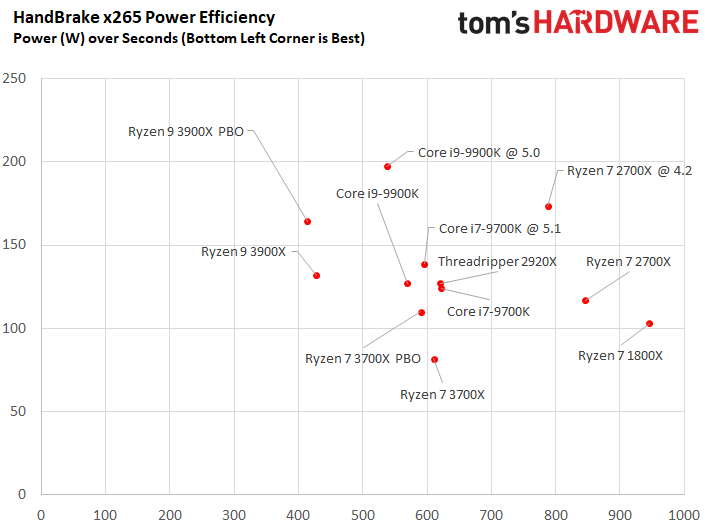


If we use Y-Cruncher as a test, a multi-threaded AVX based benchmark, things settle back to more expected results. At stock, the 3900X uses 115W while the i9-9900K uses 126W. Raise the Intel to 5GHz and use PBO on the 3900X, the Intel CPU consumes 196W while the AMD uses a mere 147W. When looking at the Handbrake results at stock speeds, both processors use about the same power (138W). When overclocked, the i9-9900K uses a fair amount more here as well. But while overall power measurements are important, they are more useful when we use them to gauge how much work is done per watt. In that case, AMD wins handily due to the power-efficient 7nm processing cores.
AMD’s Ryzen 9 3900X also has the new Collaborative Power Performance Control 2 (CPPC2) feature, whichmanipulates Ryzen 3000's power states from within the operating system. This is similar to Intel's Speed Shift technology and reduces power state transition latency. Ultimately, that results in a more efficient processor during all facets of operation.
Winner: AMD
We chose AMD here due to its overall efficiency. Although during the AIDA testing it used a bit more power, we cannot lose sight of the fact that it is doing so with a 50% core/thread count advantage. Once overclocked, the Intel really starts sucking down the power and uses nearly 33% more than the AMD with PBO enabled.
Value
Going by MSRP, the Ryzen 9 3900X will cost $499. At that price point, you receive a 12-core 24-thread processor with speeds up to 4.6 GHz when using PBO along with a proper motherboard and appropriate cooling. The i9-9900K’s MSRP is $488, and it can be found around that price and lower, especially after the launch of AMD’s new Ryzens. For that price, you receive an eight-core 16-thread processor that can run up to 5 GHz on two cores.
But it’s not all about the cost of the CPU and how many cores/threads they include. The X570 motherboards are, on average, a bit more expensive -- they certainly peak higher than any Z390 based motherboard, so that needs to be taken into account as well. It will not typically be a make or break situation, however, if you are going for a high-end X570 motherboard, be prepared to shell out a few hundred dollars or more. Luckily, AMD has left the option to use X470 motherboards with the Ryzen 3000 processors, so there is a value alternative.
Winner: AMD
Zen 2 is a game-changer for the market, shoehorning more cores and threads into a CPU on a mainstream platform than ever before. The difference in gaming at stock speeds isn’t much and we have seen when the Ryzen 9 3900X can utilize all of its horsepower in multi-threaded productivity applications. For the price, and in particular if you can use all the cores and threads while opting for a lower-priced motherboard (remember, you can go with an affordable X470 board if you don’t need PCIe 4.0 support), AMD wins this round with ease.
The Bottom Line
Looking back at our results, they go back and forth with the Ryzen 9 3900X the better overall processor in features, productivity, power consumption, and value while the i9-9900K had a lot better overclocking potential, better gaming performance (in particular when overclocked and running 1080p), as well as more motherboard options at an overall cheaper price point (if we don’t take Ryzen 3000’s backward compatibility with X470 into account).
In our testing, the nod goes to the AMD processor, as overall performance in gaming (at stock/PBO) was within a few percent, and AMD’s CPU walks away from Intel’s on any productivity application that can use all the cores and threads Zen 2 has to offer.
AMD’s value proposition isn’t as strong if you plan on running one of the high-end X570 motherboards, but on the flip side, if you already have a capable X470 motherboard, that cost doesn’t come into play at all. Also, if you want a new chip but don’t need PCIe 4.0, buying a new X470 motherboard is easy on the pocket and there are plenty of options.
If you are primarily a gamer looking for the most FPS possible for high refresh rate gaming at 1080p, the Core i9-9900K is the way to go. Otherwise, AMD’s overall performance affords it a victory in this head-to-head.
Rounds:
| Header Cell - Column 0 | Intel Core i9-9900K | AMD Ryzen 9 3900X |
|---|---|---|
| Features | Row 0 - Cell 1 | ✗ |
| Motherboard Options | ✗ | Row 1 - Cell 2 |
| Overclocking Potential | ✗ | Row 2 - Cell 2 |
| Gaming Performance | ✗ | Row 3 - Cell 2 |
| Productivity Performance | Row 4 - Cell 1 | ✗ |
| Power Consumption | Row 5 - Cell 1 | ✗ |
| Value | Row 6 - Cell 1 | ✗ |
| Total | 3 | 4 |
Overall Winner: AMD
More Face-offs:
- AMD Ryzen Threadripper 2 vs. Intel Skylake-X: Battle of the High-End CPUs
- AMD Ryzen 2 vs. Intel Coffee Lake: What's the Best CPU Platform?
- CPU Hierarchy - A Comparison of AMD and Intel Processors

Joe Shields is a staff writer at Tom’s Hardware. He reviews motherboards and PC components.
-
feelinfroggy777 Even die-hard Intel loyalist will have a hard time choosing the 9900k over the 3900xReply -
Kai Dowin I find it a bit underwhelming that "motherboard options" is a first-class-citizen comparison parameter. Both platforms have a great range of budget, mid-level, and enthusiast motherboards; And, as a matter of fact, AM4 tend to be cheaper when comparing feature-compatible boards against Z390. Once you settle on a board you won't be changing it week after week.Reply
The way I see things, that is trying a bit too hard to give some notion of parity of the 3900X to the i9-9900K. -
joeblowsmynose ReplyKai Dowin said:I find it a bit underwhelming that "motherboard options" is a first-class-citizen comparison parameter. Both platforms have a great range of budget, mid-level, and enthusiast motherboards; And, as a matter of fact, AM4 tend to be cheaper when comparing feature-compatible boards against Z390. Once you settle on a board you won't be changing it week after week.
The way I see things, that is trying a bit too hard to give some notion of parity of the 3900X to the i9-9900K.
I have no clue how Intel "won" that category ... even in the section of the article, almost all nods went to the AM4 platform, then the article quickly concluded with "Intel mobos are cheaper" (what?), and "partial wireless AC"? (What even is this? I use a cable with my PC for transmission quality and speed reasons) - and then appoints Intel the winner ... discounting the fact you can run a 3900x in $50 motherboard if you want (saw it on youtube) due to the massively superior compatibility - and with AMD you get vastly superior range or prices and options without contest.
Seriously? Giving Intel the win on mobos is 100% wrong without question. I guess they wanted it to look like a closer battle ... so just arbitrarily gave this one to them? -
joeblowsmynose Replyfeelinfroggy777 said:Even die-hard Intel loyalist will have a hard time choosing the 9900k over the 3900x
If all you do is game with a bottlnecked CPU, "need" to choose Intel for whatever reason, can afford the extravagant cooling and PSU/ motherboard requirements, and don't care about spending more than its worth, then the 9900k is still the best for you. :)
But yeah, I never would have bought that before anyway. I care too much about finding that sweet spot in getting value for my money. And while at least Intel isn't still trying to peddle a six core for $800CAD like they were just over three years ago (which I almost bought, thank God Ryzen came!), they still have to come down on pricing more yet to be competitive with AMD ... -
NightHawkRMX Sure z390 boards start at less money than x570, but these cheap z390 boards are crap and cant handle a 9900k.Reply
Even cheap x570 boards look like they can handle a more power efficient 3900x.
Also, if x570 is too pricy, sub $100 b450 boards with bios flashback will work without the need for a 2000 cpu.
Sure, older h370 and h310 board will also support the 9990k, but no way their vrms would handle it either. -
joeblowsmynose Replyremixislandmusic said:Sure z390 boards start at less money than x570, but these cheap z390 boards are crap and cant handle a 9900k.
Even cheap x570 boards look like they can handle a more power efficient 3900x.
Also, if x570 is too pricy, sub $100 b450 boards with bios flashback will work without the need for a 2000 cpu.
Sure, older h370 and h310 board will also support the 9990k, but no way their vrms would handle it either.
Saw a guy put a 3900x into a $50 A320 mobo and it worked :) -
NightHawkRMX Yep. Msi gave 3rd gen updates to all a320 boards.Reply
I saw a 12 core 3900x working in a 2.5 year old low end b350 board. -
TidalWaveOne The motherboard win should have gone to AMD. Should not have disregarded the HUGE benefit of 3900X being backward compatible with pre-X570 motherboards. Please fix so you guys don't look so silly.Reply -
Barty1884 Replyjoeblowsmynose said:If all you do is game with a bottlnecked CPU, "need" to choose Intel for whatever reason, can afford the extravagant cooling and PSU/ motherboard requirements, and don't care about spending more than its worth, then the 9900k is still the best for you. :)
Some people definitely fall into the "only care about the best gaming performance, regardless of cost" category.
feelinfroggy777 said:Even die-hard Intel loyalist will have a hard time choosing the 9900k over the 3900x
I could still see a decent number of users still doing so.
Ultimately, people buy 2080TI's etc, for their raw performance, not from a "value" standpoint. So the same can be true on a CPU front.
I don't agree with that logic at all, and (as an arbitrary) example, 95% of the performance for 60% of the cost is a no-brainer to me........... but I'm sure there's still going to be a decent market for a 9900K, or whatever it's replacement will be in time.
remixislandmusic said:Yep. Msi gave 3rd gen updates to all a320 boards.
I saw a 12 core 3900x working in a 2.5 year old low end b350 board.
Gigabyte have at least one too:
Update AGESA 1.0.0.2 for 3rd Gen AMD Ryzen™ CPU full support
https://www.gigabyte.com/Motherboard/GA-A320M-S2H-rev-1x/support#support-dl-bios
I wouldn't imagine it's a great idea long-term
TidalWaveOne said:The motherboard win should have gone to AMD. Should not have disregarded the HUGE benefit of 3900X being backward compatible with pre-X570 motherboards.
I read the "win" to be solely on number of boards available (X570 vs Z390) and nothing else, given the last couple of paragraphs.
In total between the five major AIBs (ASRock, Asus, Biostar, Gigabyte and MSI), users currently have thirty X570 boards to choose from. Each board partner has a full range of boards and feature sets from ITX to E-ATX, and covers a wide gamut of pricing and features.
Between the same five board partners, there are 58 boards to choose from just on Z390. This does not include Z370 or the lesser chipsets in B360 and H370 (which can’t be used for CPU overclocking).
However, the biggest "feature" to me is:
Ryzen CPUs is backward compatibility with previous-generation chipsets. Support goes all the way back to B350
So, yeah, I would've given the 'win' to AMD in that category too. -
salgado18 For Intel, only the top-end Z370 and Z390 motherboards allow the i9-9900k to overclock, and some of them can barely handle the power consumption of the chip. Even if there are many more motherboards, the mid-to-lower ones cut down an important feature of the CPU.Reply
Meanwhile, only the cheaper A320 forbid the Ryzen 9 3900X from overclocking, and most boards in the market can handle it (even some A320).
I believe, then, that there are more useful motherboard options on the AMD side. Or, if general cost and maturity is a factor, give it a tie. But Intel definitely does not win this round.




